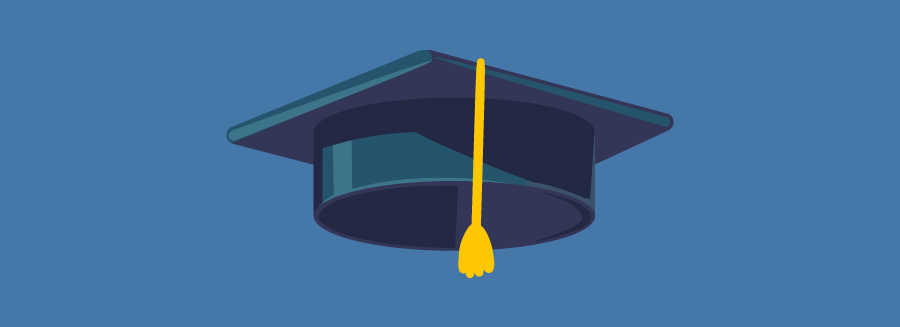Growing up I didn’t often consider if what I was learning would be useful or applicable to me in life outside of school. In fact, I didn’t think a lot about what I would do after I completed school at all. I was almost exclusively focused on getting done what I had to in order to graduate. Instead of understanding that the education I received was just the beginning of my journey and having the mindset of learning being an ongoing process, I thought I would leave school feeling mostly equipped to do whatever I wanted to do. I looked at graduation as the destination, not simply the end of the first chapter of lifelong learning.

So, when I graduated high school and started college, I was completely lost when I was told I had to pick a major by my sophomore year. Most of my education up until this point had not been something I could choose. I followed a specific set of requirements and only a few avenues could be chosen within those requirements (i.e., Classics English or Contemporary English were two avenues that were available within the 11th grade ELA class requirement. How was I supposed to know what I was deeply interested in or passionate about? It was daunting and I felt like I was the only one struggling to figure it out.
I was fortunate to have some great educators that provided me with opportunities to experience subject matter that I truly enjoyed. For example, one of the most memorable courses I took was when I was able to participate in a real-world experience in an early childhood classroom. I learned about the psychology of child development, and then I was able to actually work with children. The class was fun, and it piqued my interest, so I decided to investigate elementary education in college. I took a class that offered a field experience in a fourth-grade classroom, and it ended up becoming one of my majors.
Another significant class for me was English during my senior year of high school. My teacher connected art history to the text we were reading to help give context and to provide more Velcro to the author’s time period. I am sure to some of my classmates this wasn’t exciting, but to me, it sparked a curiosity. And that curiosity led me to take an Introduction to Art History course my freshman year of college. And that ignited a passion that drew me to also major in Art History.
It was in these moments of exploration and experimentation that I learned the most about myself…
The educators who brought in outside content and experiences had a significant impact on the path I chose to pursue in college. It was in these moments of exploration and experimentation that I learned the most about myself, and I think that is true for many. So, if we are truly trying to prepare our students for their world, how can we provide them with more opportunities to discover their interests?
Sprinkle in your passions and other tangential content that might spark a curiosity for someone. It’s important that educators share our interests outside of teaching, just as my English teacher did with Art History. It demonstrates to our students that we are lifelong learners, and that learning doesn’t stop when school ends. In addition, get excited and show that excitement (authentically) to your students! This can help cultivate a community of learners in your classroom, where new information and understanding is celebrated and not something that students feel like they have to do in your classroom. If you can introduce them to a wide variety of topics, provide them with many outlets for creativity, and give students some autonomy to explore ideas, it might just ignite a curiosity that they pursue later.
Lean into your students’ interests and allow them to ask questions and pursue answers. One of the most powerful ways we can prepare our students for the world they will one day enter is to teach them how to learn. With technology continuously improving, information is more accessible to us than ever, and that will only continue to advance. Employers are looking for employees who can take that information and think critically to problem solve; to innovate; to work together to explore new possibilities. Therefore, when you can, give them the space to explore things they are interested in. When they learn the process of asking questions, exploring their curiosities, and researching to find answers, they are learning important twenty first century skills. You can foster these skills in many ways. For example, implement some time for passion driven work in your classroom, a nod to Google founders’ 20% initiative where employees were invited to spend up to 20% of their time exploring something unrelated to their direct work that they were interested in. Or rather than focusing projects on specific topics, give your students opportunities to choose the content and structure your projects around standards instead.

Embed opportunities to practice and reflect on how what you are doing in your classroom is relevant to the world. If we want our education to truly have an impact and prepare our students for their futures, this needs to be at the forefront of our minds when we are planning instruction. Even though it can seem obvious; most students need you to help them connect the dots to understand real-world connections to content. And, talking about it is different from actively exploring and experiencing it as a learner. It doesn’t stick with others as easily when you mention it, and there is a deeper level of understanding that comes when students do the work themselves. So, work to make sure students are actively exploring these connections, and you can partner with community members to help with this process. For example, at my high school, there was a class that gave students a chance to work in small groups to set up their own food distribution process where they partnered with local restaurants to sell food at school at specific times throughout the week. The learning occurred throughout the process of setting up their “business” within the school, working with different local restaurant owners, and collaborating with their peers to make it happen. You might incorporate more project based learning as a vehicle to guide students through their learning. Look for problems in your community that could connect to your content area. Examples might be teaching students about waste and practicing living more sustainably by working on a better school-wide recycling system. Or have students learn about journalism and video production by giving them time to work together to make a show or short movie that you broadcast to an actual audience. Connect the film’s subject matter to content you might typically cover in your classroom.
Check out other examples of what PBL can look like here.

If we can give our students time to discover more connections to content and the world around them, the learning they do will stay with them because you have provided them with authentic meaning and purpose. This makes the learning more engaging and facilitating these relevant experiences might even allow your students to learn more about themselves and their futures in the process.






